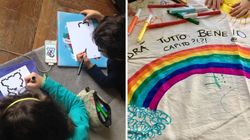These past few weeks, as we’ve all adjusted to life during a pandemic, a new set of words has entered our collective vocabulary. Suddenly more people are saying things like “Practice social distancing,” “We need to flatten the curve” and “Immunocompromised people are at a higher risk.” These phrases come up in conversations with friends and family, on social media and in just about every news article.
All these new terms can be hard to keep up with, so to simplify your life, we have compiled a glossary of the essentials. Consider this your coronavirus dictionary:
Community spread
“Community spread” refers to confirmed cases of the virus that have an unknown origin. They cannot be traced back to international travel or to a known contact with someone who is sick.
Comorbidity
“Comorbidity” is when a person has more than one disease or condition. For example, if a patient who has high blood pressure and is a diabetic gets sick with Covid-19, then they are said to have comorbidities. This is significant because patients who have other comorbidities are at a higher risk for complications due to Covid-19.
Coronavirus
Although the terms “coronavirus” and “Covid-19” are often used interchangeably, coronaviruses are actually a family of viruses, some of which cause diseases in humans and some of which do not. The virus we are so worried about right now is called SARS-CoV-2, which is not to be confused with the SARS disease everyone was so worried about in 2003. Instead, SARS-CoV-2 causes the disease Covid-19. (Confused? You are not alone. Don’t worry too much about the semantics, as most people will understand what you are talking about if you say either “the coronavirus” or “Covid-19.”)
Covid-19
Covid-19 is the disease caused by the coronavirus SARS-CoV-2. This is similar to how AIDS is the disease caused by the virus known as HIV. The term “Covid-19” refers to the set of symptoms caused by this specific form of coronavirus.
Epidemic
A disease event might be classified as an outbreak, an epidemic or a pandemic depending on how widespread it is. An outbreak is a sharp increase in the number of people who are sick with one disease. An epidemic is a sharp increase in the number of people who are sick, with this increase spread out over a wide region. A pandemic is a global disease outbreak. On March 11, the World Health Organisation formally declared that we are in a pandemic.
Essential jobs
Essential jobs are, in a nutshell, all of the jobs required to keep our society running. These are the employees who are required to report to work, even when everyone else has been ordered to stay home. What’s considered an essential job may vary, depending on local concerns and the nature of the emergency, but they generally include hospital staff and law enforcement, as well as people who work at gas stations, grocery stores and pharmacies.
Flatten the curve
By now, there’s a good chance you’ve heard at least one person talk about “flattening the curve.” Maybe you’ve seen some version of a chart with curving lines depicting different public health outcomes, like what would happen with no proactive health measures and what could happen with different ordinances of varying strictness in place. “Flattening the curve” essentially means slowing the spread of the disease, because if everyone gets sick all at once, it will overwhelm the hospital system.

Incubation period
The incubation period is the amount of time between contracting a virus and showing symptoms. For the coronavirus, this is between two and 14 days, with the average amount of time about five days. People who are infected can spread the disease before they show symptoms, which makes containment measures such as quarantine and social distancing especially important.
Immunocompromised
You know that person who is always the first to catch whatever bug is going around? Someone who is immunocompromised is like that, only worse. Their immune system has been weakened to the point that their body may not be able to fight off normal illnesses, let alone a serious one like Covid-19. Conditions that can cause a person to be immunocompromised include heart disease, lung disease, diabetes and HIV/AIDS. Chemotherapy and steroids can also weaken a person’s immune system.
Isolation
Isolation separates people who are sick with Covid-19 from other people, in order to stop the spread of the disease.
Lockdown
A lockdown is when all nonessential activities get shut down, with nonessential employees being ordered to work from home. The exact conditions of a lockdown will vary, but for a number of states, it means schools, bars, movie theatres and restaurants are closed, though food delivery may still be allowed. People can still leave their homes to go to essential places, including gas stations, grocery stores and pharmacies. Some states are instituting curfews.
Mild symptoms
When it comes to Covid-19, the term ”mild symptoms” can be a bit misleading. A mild case of Covid-19 might simply feel like a cold, or it could include symptoms as serious as fever, cough and pneumonia ― but not to the point where you need to be hospitalised. Roughly 80% of cases are mild, while the rest are classified as “severe” or “critical.” A case is considered severe when you need oxygen or a ventilator to breathe. Critical cases involve respiratory failure or multi-organ failure.
Mitigation strategies
Mitigation strategies are preparations that a community can take to slow the spread of disease and protect high-risk individuals and critical infrastructure, such as hospitals. Measures include closing schools, limiting public gatherings and providing people with the necessary support to take preventive measures.
Outbreak
An outbreak is when there is a sharp increase in the number of people sick with one disease, but these cases remain in one area. If an outbreak spreads to a wider area, it becomes an epidemic, and if it spreads worldwide, it becomes a pandemic.
Nonessential surgery
Also called an “elective surgery,” this is a surgical procedure that doesn’t have to be done immediately. The American College of Surgeons recently released their recommendations for elective surgery, noting that although some surgeries can postponed indefinitely, many are for progressive diseases that will worsen over time. If you are scheduled to have an elective surgery, it’s important to talk with your doctor and assess the relative risks of delaying the procedure.
Pandemic
A pandemic is when there is a sharp increase in the number of people who are sick with a disease, which has spread around the world. On March 11, the World Health Organisation officially declared that we are experiencing a pandemic.
Quarantine
Quarantines are used for people who aren’t sick with Covid-19 but have been exposed to someone who is. Quarantines work by keeping people who might get sick separated from others, to prevent them from unknowingly spreading the disease.
Respirator
A respirator filters the air you breathe, removing particles and contaminants like bacteria, viruses, mould and smoke. Generally speaking, respirators are either disposable or have filters that can be swapped out. For health care workers, respirators offer vital protection against getting sick. It’s important that a health care worker’s respirator fits correctly, gets used properly and is the right quality.
SARS-CoV-2
“SARS-CoV-2” is the official name of the virus that causes the disease Covid-19. Not a lot of people use the official name, instead saying “Covid-19” or “the coronavirus.” Even the World Health Organisation has backed away from the term “SARS-CoV-2,” saying instead “the virus that causes Covid-19” in order to avoid confusion with the disease SARS, which caused an outbreak in 2003.
Social distancing
“Social distancing” means keeping a distance of at least six feet from other people, and avoiding gatherings and unnecessary travel, in order to limit the spread of disease.
Stay in place
“Stay in place,” also called “shelter in place,” refers to conditions where no one is allowed to leave their home, except to run errands such as going to the grocery store or pharmacy. In most places, going for a walk is also acceptable, as long as people stay six feet away from each other. Essential workers are also allowed to leave for work.
Ventilator
A ventilator is a machine that moves breathable air into and out of the lungs, for patients who are physically unable to breathe, or can’t breathe sufficiently on their own. The most critical Covid-19 patients need ventilators, and there are worries that we won’t have enough for everyone who will need one.


